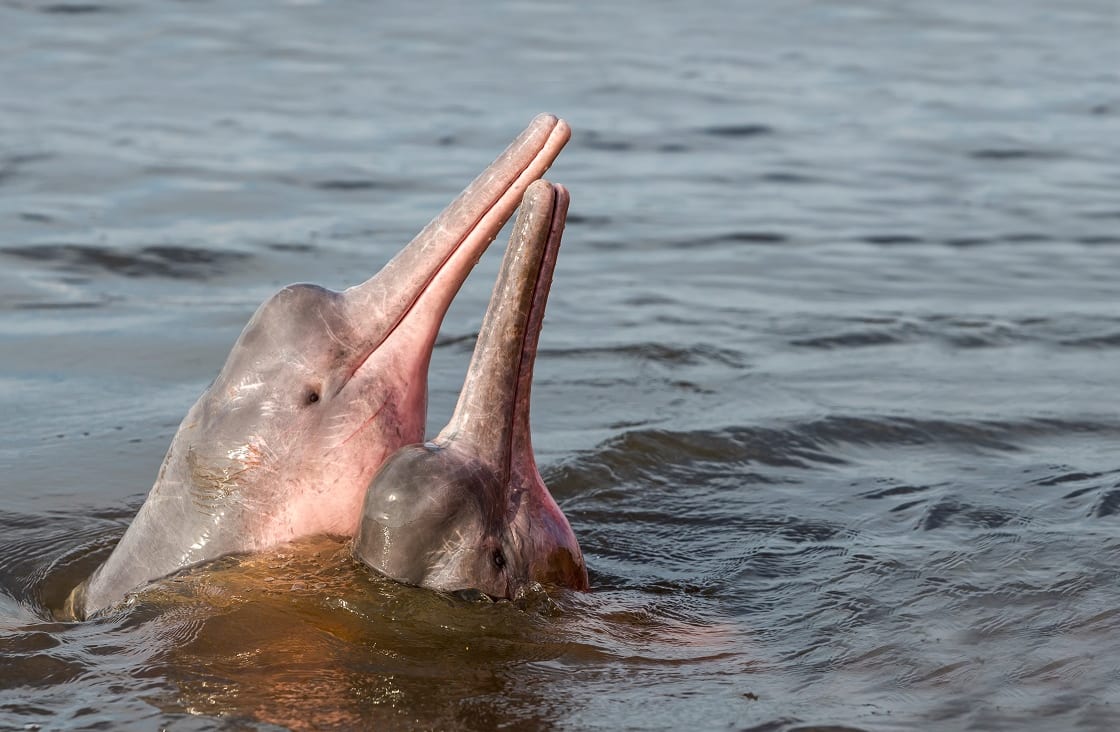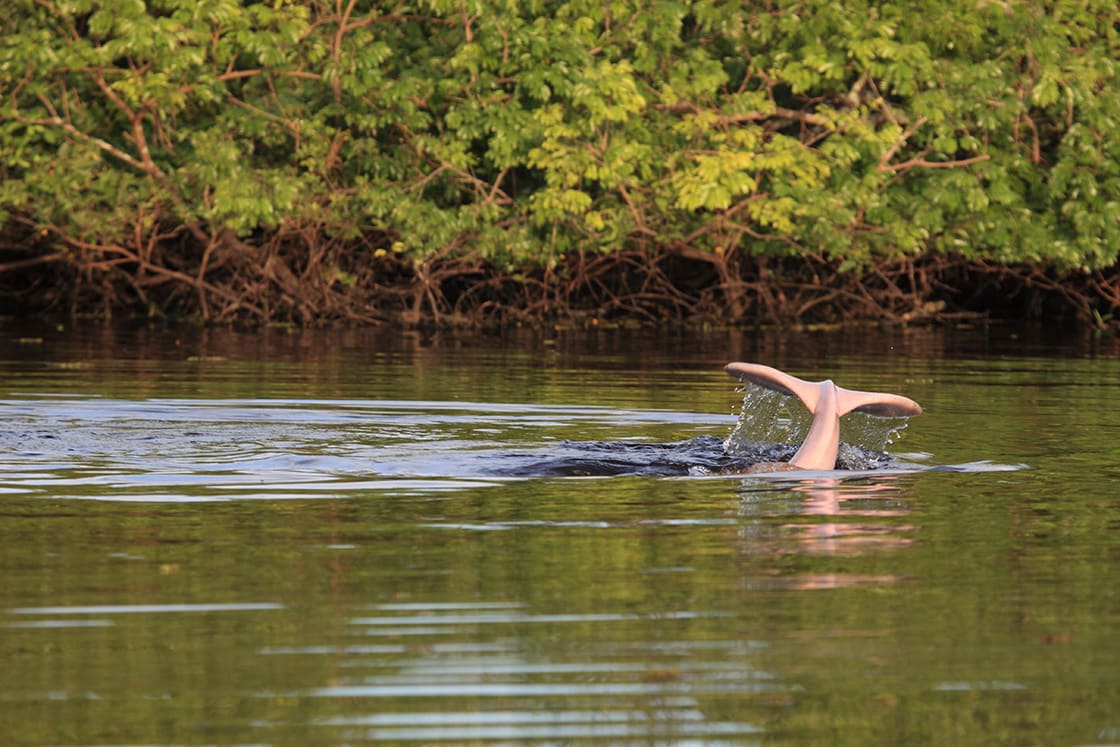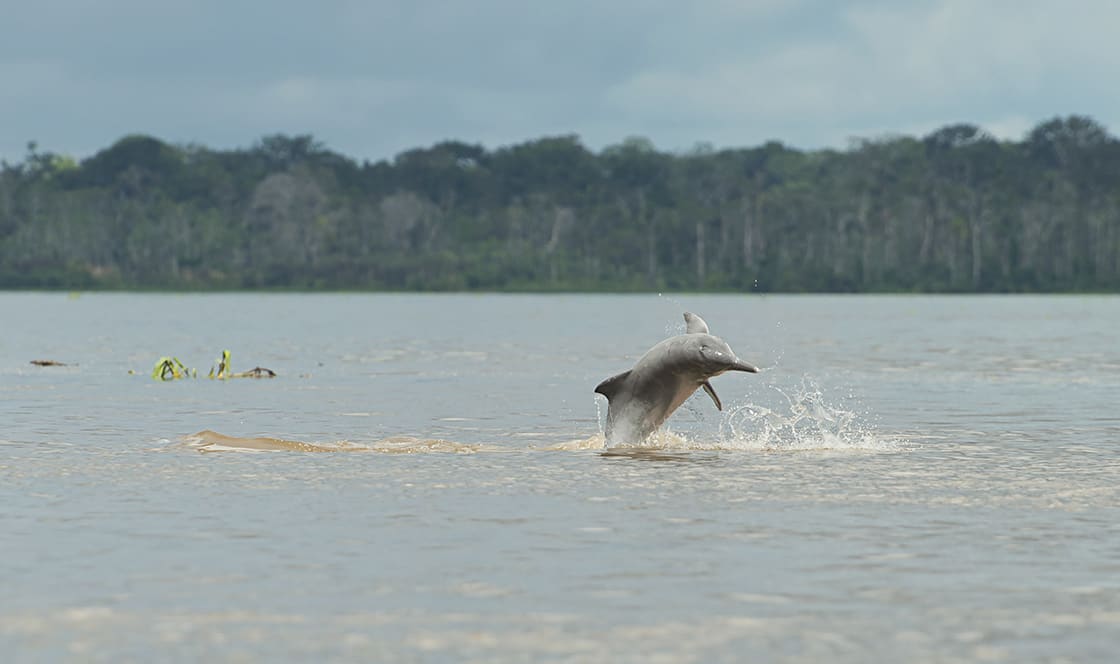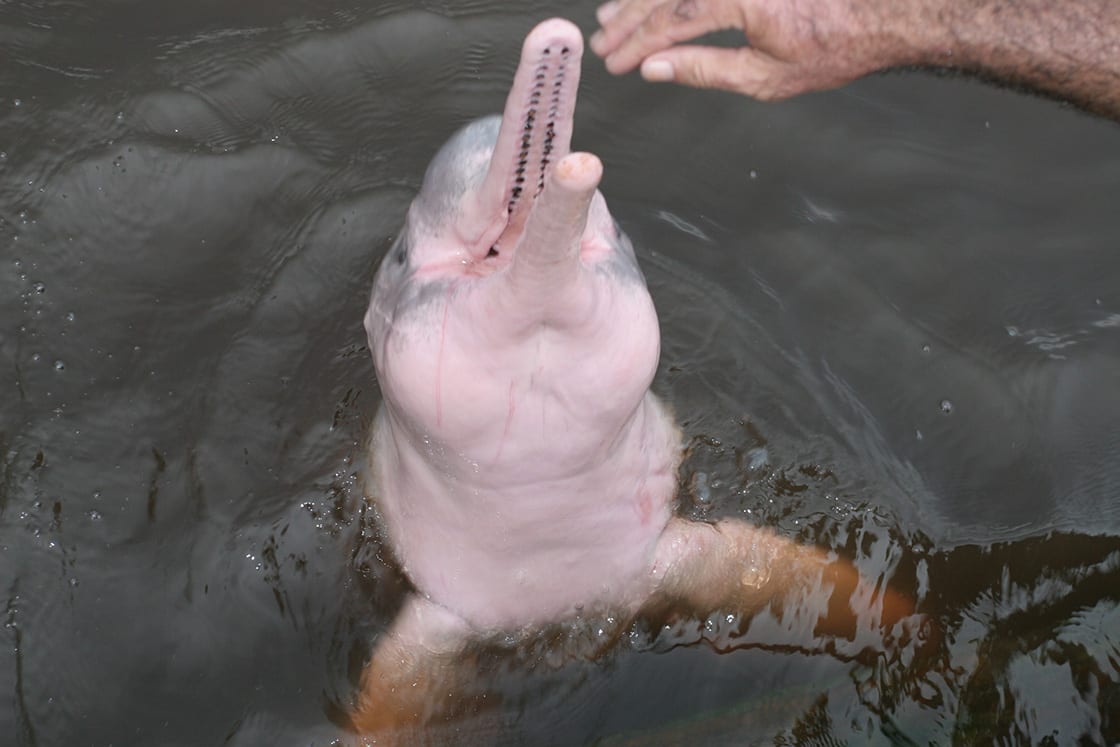
With so many exotic species living in the Amazon rainforest, most people forget that it’s not only the rainforest canopy and dense undergrowth that is home to wildlife. The Amazon River itself is teeming with rich biodiversity: in the dark waters swim piranhas, crocodiles, manatees, and one of our favorites, the Amazon river dolphin.
Known to locals as the Boto, or more frequently referred to as the Pink River Dolphin on account of its distinctive coloring, these fascinating creatures are steeped in myth and legend and have evolved to be highly specialized to their environment. Learn more about them before you head to the Amazon with these 15 interesting facts about Pink River Dolphins below.
Despite their name, there are actually two other species of river dolphin (the Bolivian and Araguaian) and the oceanic Gray Dolphin (known to locals as the Tucuxi) that also call the Amazon river home. However the pink river dolphins are undoubtedly the most recognizable.

Pink Dolphin Diving In A Bolivian River
The Amazon River dolphin can be found in the Amazon River as well as the Orinoco River basin and the upper Madeira River. These river systems flow throughout South America, specifically in the countries of Brazil, Bolivia, Ecuador, Venezuela, Colombia, Guyana and Peru.

Pink Dolphin In The Amazon River
Pink Amazon river dolphins are not the same dolphins you may find in the ocean (like the tucuxi which is not closely related to them genetically) and have quite a few special adaptations to their habitat. In truth, they are actually only distantly related to sea dolphins. Additionally, their appearance is quite distinct, and you’ll notice they often only tend to just breach the surface, rather than jumping high out of the water like gray dolphins. They are slightly smaller than sea dolphins with Amazon river dolphins averaging about 6.5 feet in length and weighing between 185 and 355 pounds when fully grown.
Amongst the five living species of river dolphins, pink Amazon river dolphins are the most intelligent, with a brain capacity that is 40% larger than that of humans.
There is an Amazonian legend that the pink river dolphins stalk the rainforest at night disguised as handsome, white-hat wearing men (the hat is used to hide their blowhole) in order to seduce and impregnate innocent local women.

River Dolphins have different colors
They come in all shades of pink, from a dull gray-pink, to rosy colored pink, to a bright pink like that of the flamingo. There are various theories for this. Some believe age is a factor, with younger dolphins being gray and they get pinker with age, with adult males usually the pinkest. Others argue the color variation is due to the clarity of the water in which the dolphin lives: the darker the water, the pinker the dolphin will be as the sun’s rays cause the dolphins to lose their pink pigmentation. Another theory is the coloration is a way to camouflage themselves against the reddish mud that occurs in some stretches of the river to help avoid being noticed by predators.
Amazon river dolphins are also known to flush a bright pink color when they become excited!
There are several anatomical differences between the Amazon River dolphin and other types of dolphins. For one, Amazon River dolphins are able to turn their necks from side to side while most species of dolphin cannot. This trait coupled with their ability to paddle forward with one flipper, while paddling backward with the other helps them maneuver when the river floods. These dolphins will actually swim up over the flooded land and their flexibility helps them to navigate around trees.
Additional characteristics that set these dolphins apart from other species are molar-like teeth that allow them to chew their prey and bristle-like hairs at the ends of their snouts that help them search for food on the muddy river bottoms.
Pink river dolphins are often assumed to be blind because their eyes are small and the visibility in the murky waters of the Amazon is so poor, but in fact they have pretty good eyesight and are known to be very inquisitive, even looking into your eyes.
Amazon River dolphins feast on over 50 types of fish, as well as shrimps, crabs and even small turtles, which they find at the bottom of the river. They swim towards the top, often looking down, and use echolocation to help them hunt. Their aforementioned flexible heads also help, being able to turn a full 180 degrees allowing them wider visibility.
They swim up to 30 kilometers per day, however they move quite slowly as they are always on the lookout for food.
While there are more Amazon river dolphins than any other river dolphin, they are among the most endangered species of the world’s cetaceans. They are currently listed by the International Union for the Conservation of Nature (IUCN) as “endangered species-threatened”.
Although these dolphins have long been respected and unharmed because of the local belief that they have magical powers, these beliefs are changing. Fishermen have been known to kill them because they are seen as competition, but also to use them as bait for catfish. Accidentally the dolphins often become tangled in their nets too.
Unfortunately, increasing destruction of the Amazon basin has put them at risk, due to loss of habitat and a decrease in food sources. Rising levels of contaminants such as mercury have caused and increased the number of deaths among them, especially near gold mines as the process involves the use of mercury. The building of hydroelectric dams in South American rivers, The increase of traffic in the Amazon river has also altered their habitat, one of the reasons it is so important for visitors to travel with responsible companies.

Pink Dolphin Swimming With Tourists
Those brave enough to swim in the Amazon River can have the opportunity to swim with the pink river dolphins as knowledgeable guides know where the Amazon river dolphins like to hang out.
If this Pink river dolphin fact file has made you want to see these fascinating creatures for yourself, why not take an Amazon River cruise or a specially curated Amazon tour to see pink dolphins in the wild? You never know, maybe you’ll learn a few more pink river dolphin facts for yourself first hand.
While Rainforest Cruises aim to provide accurate and up-to-date information, we make no representations as to the accuracy or completeness of any information herein or found by following any link on this site. Rainforest Cruises cannot and will not accept responsibility for any omissions or inaccuracies, or for any consequences arising therefrom, including any losses, injuries, or damages resulting from the display or use of this information.




